Insight into Sikhism
Exploring Interfaith with Unificationists: In this segment of this series, we have a testimony from Naria Gaarder, Program Coordinator for Youth and Students for Peace, who visited the Gurudwara Sikh Temple in Glen Rock, NJ to learn more about Sikhism.
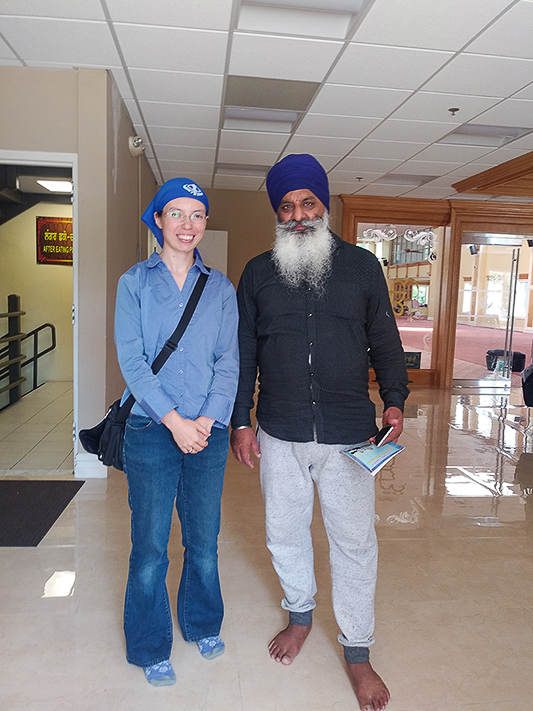
When I was young, I wondered why some people wore turbans and what religion they belonged to. I have since learned that people who practice Sikhism wear turbans, but that was about all I knew about Sikhism.
In July, I called a local Sikh Temple called Gurudwara in Glen Rock, NJ ̶ it was only 10 minutes from my home ̶ to ask if I could come visit to learn more about their religion. They told me which days and times they have prayer services and even invited me to come during their children’s camp. I decided to go on one of the camp days to get to know the youth and see what kind of activities they had.
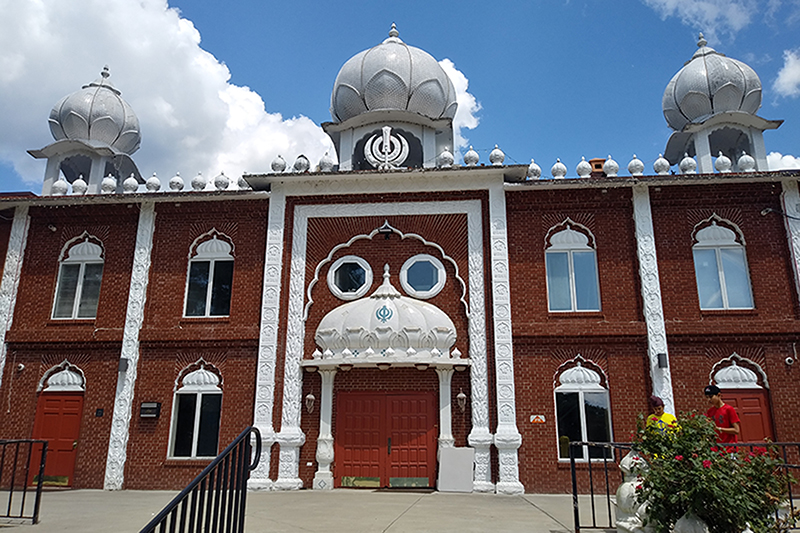
On the day of, I pulled into the parking lot of the Gurudwara, which was located in a nice, wooded neighborhood. The building was a beautiful brick structure with white accents and tower tops shaped like flower bulbs, like the ones you might see in an Arabian Nights illustration. I entered a clean and open foyer with rooms on either side to store your shoes. The ladies there explained that I had to take off my shoes and cover my head before entering the prayer hall, or Darbar Hall. I did not bring a scarf, but a basket of handkerchiefs was provided for anyone who needed it.
I met with Paramjeet, a middle-aged woman leading the children’s camp, who showed me around the building and explained the rules and practices when in the Temple. While inside the Gurdwara, one is expected to keep his or her head covered at all times, which, in the Indian culture, shows respect to one’s elders. Shoes are removed while in the Temple and hands must be washed before going inside the Darbar Hall. In the Darbar Hall there is a raised platform decorated in beautiful fabric with a canopy hanging above it. This is where the sacred text, the Guru Granth Sahib Ji, is kept. This text is the Eternal Guru, or teacher, and is treated with the utmost respect. Anyone can sit on the platform to read from the book, but it should be done with a certain respect and reverence since it is considered a great privilege to be able to sit there and read from the holy texts. The person reading also swishes around a fluffy fan, or the Chaur Sahib, which shows respect to the sacred text and is most likely a tradition that carried over from the early eras.
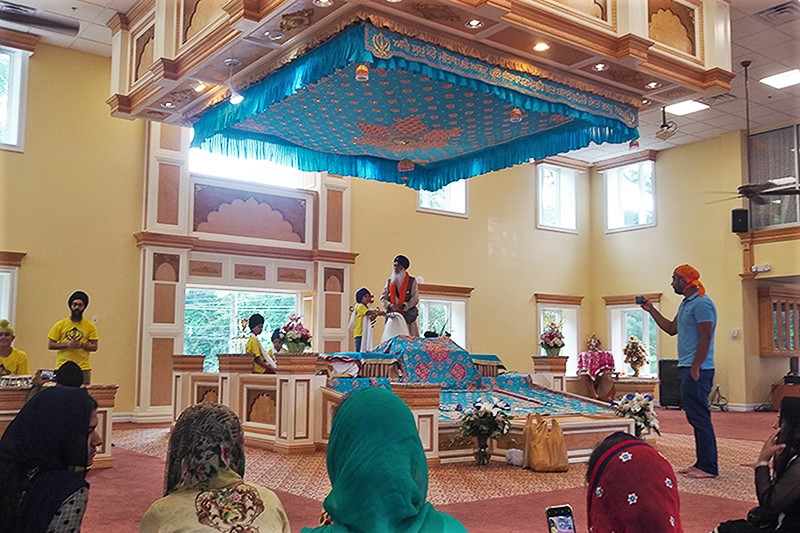
Afterwards, I was taken downstairs to the Langar Hall where they serve food to anyone, no matter who you are or where you come from. The tiled floor had rows of narrow carpets for people to sit. They do not prepare or eat any meat or eggs to show respect for life while in the holy building, although being a Sikh does not mean you have to be vegetarian. The food was served from a push cart that traveled up and down the aisles, ladling food onto your plate. I enjoyed a nice meal consisting of rice, lentils, a yogurt-like sauce and flat bread called “roti.”
Paramjeet introduced me to some of the high school youth who were helping as camp staff and suggested I go with them to participate. I met a 14-year-old girl, Jasmeet, who answered my questions about the different headdresses Sikhs wear. The women often wear scarves called “chunni” and the boys wear a headwrap with a bun near the front of their head called a “patka.” The boys transition to a turban when they feel they are ready to take on the responsibility, since a turban is akin to the crown of a prince. In addition, it also takes time and practice to put one on. The tenth Guru, Guru Gobind Singh Ji, said that Sikhs should wear the turban to stand out in a crowd. That way people will know who to go to for help because they are a Sikh. When I heard this, I thought, “Wow, that’s so cool! They’re like real Jedis from Star Wars!” The Sikh men might look intimidating with their turbans and big beards, but if you look at their faces, you can tell they are good-hearted people.
I joined a class of older children who were learning about their history and values and found it intriguing to see a video of other Sikh youth sharing their challenges of going to school in America where they were bullied. It reminded me of our own Unificationist youth and how they face challenges at school when explaining their values, but I felt Sikh children probably have a more difficult time. Like Unificationists, Sikhism practices no alcohol, no drugs, keeping purity until marriage and fidelity within marriage. I also learned that Sikhism is the fifth largest religion in the world and was founded about 550 years ago in India. They believe in one God who is formless and is described as the essence of energy that created all things. There were ten Gurus, or teachers, in Sikhism, with the final Guru saying that the sacred texts compiled by the past Gurus were now their Guru, hence the name Guru Grathn Sahib for their scriptures which are written in the Punjabi language.

I returned to the Temple on a Sunday to join their service and met with Janit Singh, the person I first spoke to on the phone. I participated in part of their prayer service then went to the Langar Hall to speak to Janit’s wife, Jasneet, who also answered some questions I had. From what I observed with the prayer service, people could come and go whenever during the reciting and singing of the holy texts. Some people came dressed in full traditional Indian-style garb with scarves or turbans, others were wearing regular pants and t-shirts and had a handkerchief on their head upon entering the Darbar Hall. I saw some people touch the ground with their hand then touched their head before entering, and others who didn’t.
The overall feeling I noted from this was that there were no feelings of judgement from anyone towards anyone. You simply expressed your own way of dedication and respect to God upon arrival and during the service. It is your own personal offering and it didn’t matter what others thought. The only things that mattered was what you wanted to offer yourself. If people wore a turban that was fine. If they just wore a handkerchief, that was fine, too. This shows the uniqueness of Sikh religion as they emphasize more on learning and applying the universal message of the Guru in day-to-day life, and not on ritualism surrounding the practice of worship.
The final part of the service is when everyone gathers together and prays. The person reading from the Guru opens the book to a random page. Those words are like the answers to your prayer and what to live by for the day. When everyone bows, it is a full bow to the ground and you touch your head to the floor. Everyone was served a doughy looking food made of flour, clarified butter (ghee) and sugar. It didn’t taste quite like dough, but had a lighter texture and tasty sweetness. This dough-like food is called “prashad” and is meant to nourish the body as the word of the Guru nourishes the soul.
I learned many things that are unique to Sikhism, such as being baptized. Not all people who practice Sikhism get baptized, but it is basically a commitment to live and practice a certain way of life, such as not eating meat and eggs, and to wear the five articles of faith that identify you as a Sikh, which are wearing your hair long and never cutting any hair from your body, a comb to keep your hair clean, a silver bracelet to remind you that you belong to God and what you do should be for God, a sword or representation of a sword to use for protection and to protect others, and lastly a pair of boxer-like underpants for hygiene and modesty. Both men and women can be baptized as Sikhs, and when they are baptized they drink a bowl of water which has been sweetened with nectar.
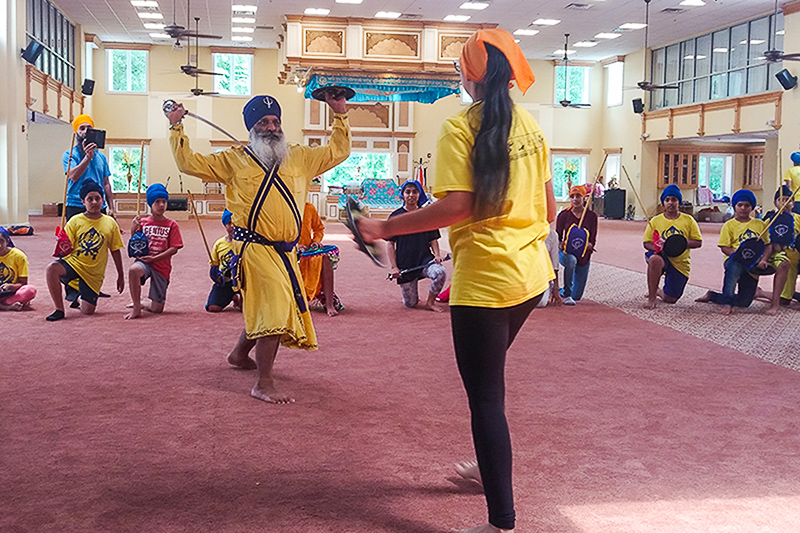
One notable aspect of Sikhism is their belief of equality, which I was able to see practiced first-hand at the Temple. When I attended their children’s camp, all the boys and girls participated in the same kind of activities. They all lead the prayers, played the harmonium or tabla (drums), swished the fan for the Guru Granth Sahib, and learned the Sikh martial arts (Gatka) with swords, shields, spears, staves, and pointy daggers. They also had a fishnet looking weapon that was used to deflect arrows.
During the Sunday Service, I saw both men and women wearing turbans, cooking, serving food and sitting at the front of the Darbar Hall. The men sat on one side and women on the other, but the kids could sit with whichever parent they choose.
Sikhs also don’t believe in the caste system which is still used in India. All people and genders are equal and they have believed this since Sikhism was founded. In the Langar Hall, everyone sits on the floor together as equals and eats the same meal. Janit also explained that as a Sikh it is customary to have the last name of Singh if you are a man and Kaur if you are a woman. The Sikhs’ tenth Guru initiated this to get rid of the inequality due to the caste system in India, where one’s last name identified their caste.
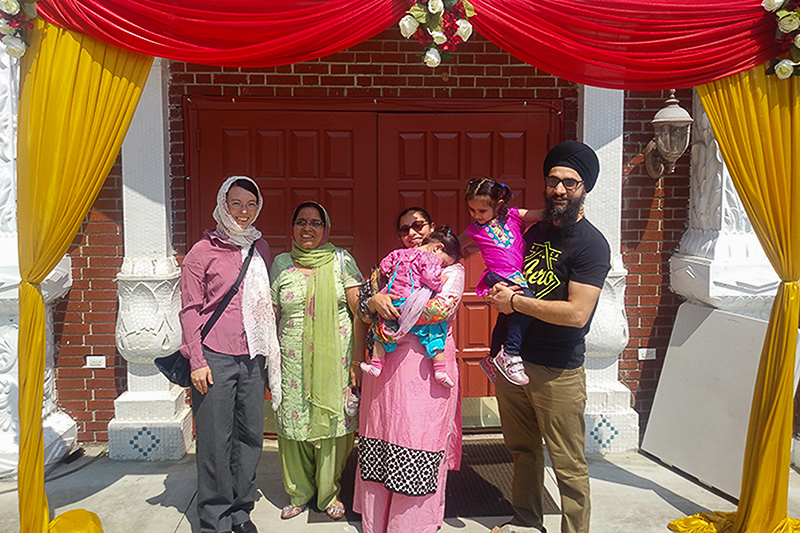
I learned a lot during my visits and am grateful to everyone who welcomed me and made me feel at home. There are still many things I would like to ask and learn, but I wanted to at least share this experience with the Unificationist communities so everyone can also learn about Sikhism.
Read about the group visit to the Gurudwara on Sunday, August 18 here.

Deanna Cooper
| #
When we lived in Tasmania we were close friends with a wonderful Indian family who practiced Sikhism. We sometimes joined them in their end-of-the-day prayer and Josie got to swish the fan. We gave them Holy Wine and although we tried to find them last year when we returned to Tasmania we found they had moved.
Reply
Jeremiah Tobin
| #
“Thank you, Naria. I always find it interesting to get an insight into other beliefs.
Reply